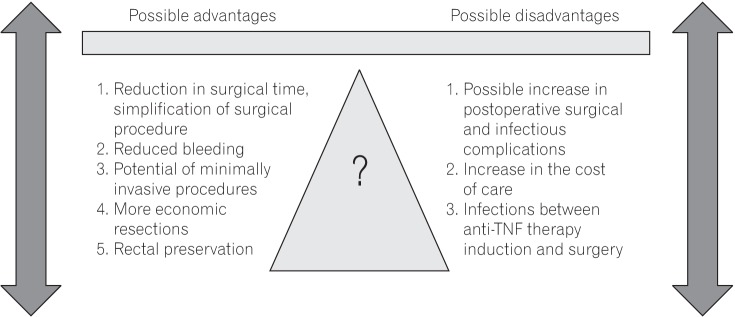Intest Res.
2017 Apr;15(2):160-165. 10.5217/ir.2017.15.2.160.
Preoperative use of anti-tumor necrosis factor therapy in Crohn's disease: promises and pitfalls
- Affiliations
-
- 1Colorectal Surgery Unit, Cajuru University Hospital, Catholic University of Paraná, Curitiba, Brazil. pgkotze@hotmail.com
- 2Institute of Translational Medicine, University of Birmingham, Edgbaston, Birmingham, UK.
- 3Department of Surgery, Academic Medical Center, Amsterdam, The Netherlands.
- 4Inflammatory Bowel Disease Unit, University of Calgary, Alberta, Canada.
- KMID: 2425156
- DOI: http://doi.org/10.5217/ir.2017.15.2.160
Abstract
- Recent advances in medical and surgical therapy were achieved during the last two decades in the management of Crohn's disease (CD). Anti-tumor necrosis factor (anti-TNF) agents are widely used worldwide. However, a significant proportion of patients still need surgical resections. The impact of previous exposure to these agents on the perioperative and postoperative outcomes is still controversial. In this critical review, we aimed to position the strategy of intentional preoperative use of anti-TNF agents in the management of CD. The indications and contraindications for this strategy are detailed, and despite scarce evidence, the possible advantages and disadvantages of the intentional use of anti-TNF agents before abdominal surgery in CD are discussed.
MeSH Terms
Figure
Cited by 1 articles
-
Emerging Therapies: What Are Promising in the Near Future?
Geom Seog Seo, Sung Hee Lee
Korean J Gastroenterol. 2018;71(2):81-88. doi: 10.4166/kjg.2018.71.2.81.
Reference
-
1. Danese S. New therapies for inflammatory bowel disease: from the bench to the bedside. Gut. 2012; 61:918–932. PMID: 22115827.
Article2. Maggiori L, Panis Y. Laparoscopy in Crohn's disease. Best Pract Res Clin Gastroenterol. 2014; 28:183–194. PMID: 24485265.
Article3. Spinelli A, Bazzi P, Sacchi M, et al. Short-term outcomes of laparoscopy combined with enhanced recovery pathway after ileocecal resection for Crohn's disease: a case-matched analysis. J Gastrointest Surg. 2013; 17:126–132. PMID: 22948838.
Article4. de Buck van Overstraeten A, Wolthuis A, D'Hoore A. Surgery for Crohn's disease in the era of biologicals: a reduced need or delayed verdict? World J Gastroenterol. 2012; 18:3828–3832. PMID: 22876034.
Article5. Narula N, Charleton D, Marshall JK. Meta-analysis: peri-operative anti-TNFalpha treatment and post-operative complications in patients with inflammatory bowel disease. Aliment Pharmacol Ther. 2013; 37:1057–1064. PMID: 23581515.
Article6. Billioud V, Ford AC, Tedesco ED, Colombel JF, Roblin X, Peyrin-Biroulet L. Preoperative use of anti-TNF therapy and postoperative complications in inflammatory bowel diseases: a meta-analysis. J Crohns Colitis. 2013; 7:853–867. PMID: 23523418.
Article7. Lau C, Dubinsky M, Melmed G, et al. The impact of preoperative serum anti-TNFalpha therapy levels on early postoperative outcomes in inflammatory bowel disease surgery. Ann Surg. 2015; 261:487–496. PMID: 24950263.
Article8. Brouquet A, Maggiori L, Zerbib P, et al. Anti-TNF therapy is associated with increased risk of postoperative morbidity after surgery for ileocolonic Crohn disease: outcome analysis in a prospective nationwide cohort of 592 patients conducted by the GETAID chirurgie group. J Crohns Colitis. 2016; 10(Suppl 1):S22–S23.9. D'Haens GR, Panaccione R, Higgins PD, et al. The London Position Statement of the World Congress of Gastroenterology on Biological Therapy for IBD with the European Crohn's and Colitis Organization: when to start, when to stop, which drug to choose, and how to predict response? Am J Gastroenterol. 2011; 106:199–212. PMID: 21045814.10. Schlussel AT, Steele SR, Alavi K. Current challenges in the surgical management of Crohn's disease: a systematic review. Am J Surg. 2016; 212:345–351. PMID: 27182048.
Article11. Coscia M, Gentilini L, Laureti S, et al. Risk of permanent stoma in extensive Crohn's colitis: the impact of biological drugs. Colorectal Dis. 2013; 15:1115–1122. PMID: 23594132.
Article12. de Groof EJ, Gardenbroek TJ, Buskens CJ, et al. The association between intensified medical treatment, time to surgery and ileocolic specimen length in Crohn's disease. Colorectal Dis. [published online ahead of print November 24, 2016]. DOI: 10.1111/codi.13567.
Article13. Frostberg E, Ström P, Gerke O, Qvist N. Infliximab's influence on anastomotic strength and degree of inflammation in intestinal surgery in a rabbit model. BMC Surg. 2014; 14:23. PMID: 24762063.
Article14. Jensen JS, Petersen NB, Biagini M, Bollen P, Qvist N. Infliximab treatment reduces tensile strength in intestinal anastomosis. J Surg Res. 2015; 193:145–152. PMID: 25156230.15. Waterman M, Xu W, Dinani A, et al. Preoperative biological therapy and short-term outcomes of abdominal surgery in patients with inflammatory bowel disease. Gut. 2013; 62:387–394. PMID: 22619367.
Article
- Full Text Links
- Actions
-
Cited
- CITED
-
- Close
- Share
- Similar articles
-
- Anti-tumor Necrosis Factor Therapy for Crohn Disease: Friend or Foe to the Surgeon?
- Could Early Anti-Tumor Necrosis Factor Therapy Change the Prognosis of Crohn's Disease?
- A Case of Multiple Tuberculosis Associated with Infliximab Therapy in Crohn's Disease
- Biological Therapy for Inflammatory Bowel Disease in Children
- Recent Trends of Infliximab Treatment for Crohn's Disease


